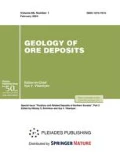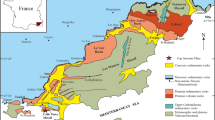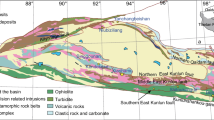Abstract
The gold deposits of the Bodaibo ore district are enclosed in a thick (several kilometers) sequence of Riphean–Vendian carbonaceous carbonate–terrigenous deposits. Gold is concentrated at several stratigraphic levels; the largest deposit in Russia, Sukhoi Log, and its counterpart, Golets Vysochaishii, are confined to terrigenous deposits of the Riphean Khomolkho Formation. The characteristic components of the Khomolkho Formation are lenticular interlayers and layered disseminations of pyrrhotite and pyrite with clearly pronounced lithological–stratigraphic control of their distribution. The Golets Vysochaishii deposit is confined to the largest thickening of sulfide layers in carbonaceous chlorite–quartz–sericite phyllite schists of the lower part of the Khomolkho Formation. The sulfide content in the ore-bearing sequence is 5 wt %; native gold is enclosed in sulfide layers. According to the data of previous researchers, based on the distribution patterns of sulfur isotopes, sulfide ore-bearing deposits of the deposit were formed by hydrothermal–sedimentary pathways. The primary gold content of sulfide sediments is assumed in analogy with the neighboring Sukhoi Log and Verna deposits. The distribution of Au, As, Ag, and carbonaceous matter in the sulfide-bearing strata of the Golets Vysochaishii deposit is substratal, reflecting their accumulation during sedimentation. The rocks were metamorphically altered under the greenschist facies conditions, during which they recrystallized and sulfides and gold were redistributed with the rocks retaining their layered structure. There are no significant differences in the contents of the rock-forming components between the ore deposit and host rocks, which indicates the absence of metasomatic alteration in rocks associated with ore formation. Metamorphic processes at the deposits of the Khomolkho Formation were accompanied by replacement of ilmenite by rutile and pyrrhotite by pyrite, as well as a change in the composition of chlorites and carbonates with increasing iron content; these processes were regulated by the fugacity of oxygen and carbon dioxide. Metamorphic alteration, based fluid inclusion study data, took place in the temperature range 230–510°C with the participation of oxidized carbon dioxide–aqueous fluids (CO2/CH4 up to 17) with a salinity of 7–12 wt % equiv. NaCl and reduced (CO2/CH4 < 0.3) methane–nitrogen fluids with a salinity of 11–13 wt % equiv. NaCl.










Similar content being viewed by others
Notes
Unpublished data: Suslov N.A., Amelin V.A. et al. Report on the Results of Prospecting for Gold Ores in the Khomolkho Ore Field and the Privachskaya Ore Zone. Irkutsk, 1978.
REFERENCES
Bryndzia, T.L. and Scott, S.D., The composition of chlorite as a function of sulfur and oxygen fugasity: an experimental study, Am. J. Sci., 1987, vol. 287, no. 1, pp. 50–76.
Buryak, V.A., Metamorfizm i rudoobrazovanie (Metamorphism and Ore Foramtion), Moscow: Nedra, 1982.
Ivanov, A.I., Main features of the geological structure and gold potential of the Bodaibo ore cluster, Rudy Met., 2008, no. 3, pp. 43–61.
Ivanov, A.I., Zoloto Baikalo–Patoma (geologiya, orudenenie, perspektivy) (Gold of Baikal–Patom: Geology, Mineralization, and Prospects), Moscow: FGUP TsNIGRI, 2014.
Ivanov, A.I., Role of metamorphic conditions of transformation of carbonaceous carbonate–terrigenous sediments for the formation of gold mineralization at different stages of collisional stages of the evolution of the Baikal–Patom metallogenic province, Otechestvennaya Geol., 2017, no. 4, pp. 3–23.
Ivanov, I.P., Shapovalov, Yu.B., and Kashirtseva, G.A., Thermodynamic analysis of mineral parageneses in the Fe–S–O2–H2O system, Eksperimental’naya mineralogiya: nekotorye itogi na rubezhe stoletii (Experimental Mineralogy: Some Results at the Turn of Centuries), Zharikov, V.A, Fed’kin, V.V, Eds., Moscow: Nauka, 2004, vol. 1, pp. 283–297.
Kolonin, G.R. and Ptitsyn, A.B., Termodinamicheskii analiz uslovii gidrotermal’nogo rudoobrazovaniya (Thermodynamic Analysis of Conditions of Hydrothermal Ore Formation), Novosibirsk: Nauka, 1974.
Kryazhev, S.G., Isotope–geochemical and genetic models of gold deposits in the carbonaceous–terrigenous sequences, Otechestvennaya Geol., 2017a, no. 1, pp. 28–38.
Kryazhev, S.G., Genetic Models and Criteria for Prediction of Gold Deposits in the Carbonaceous–Terrigenous Complexes, Extended Abstract of Doctoral (Geol.–Min.) Dissertation, Moscow: TsNIGRI, 2017b.
Kryazhev, S.G., Ustinov, V.I., and Grinenko, V.A., Fluid regime at the Sukhoi Log gold deposit: isotopic evidence, Geochem. Int., 2009, vol. 47, no. 10, pp. 1041–1049.
Large, R.R., Maslennikov, V.V., Robert, F., et al., Multistage sedimentary and metamorphic origin of pyrite and gold in the giant Sukhoi Log deposit, Lena gold province, Russia, Econ. Geol., 2007, vol. 102, pp. 1233–1267.
Large, R.R., Bull, S.W., and Maslennikov, V.V., A carbonaceous sedimentary source–rock model for Carlin–type and orogenic gold deposits, Econ. Geol., 2011, vol. 106, pp. 331–358.
Onishchenko, S.A., Pyrite metacrystals in the ores of the Golets Vysochaishii deposit (Lena gold district), Kristallicheskoe i tverdoe nekristallicheskoe sostoyanie mineral’nogo veshchestva: Mater. mineral. seminara (Crystalline and Solid Non–Crystalline State of Mineral Matter. Proc. Mineral. Seminar), Syktyvkar: Geoprint, 2012, pp. 302–304.
Onishchenko, S. A., Ilmenite and rutile in sediments of the Khomolkhin Formation (Khomolkhin ore cluster, Lena gold province, Sovremennye problemy teoreticheskoi, eksperimental’noi i prikladnoi mineralogii (Yushkinskie chteniya-2013): Mater. mineral. Seminara (Modern Problems of Theoretical, Experimental, and Applied Mineralogy. Proc. Yushkin Reading-2013 Seminar), Syktyvkar: IG Komi NTs UrO RAN, 2013, pp. 105–109.
Onishchenko, S. A., Metamorphogenic pyrite nodules in sediments of the Khomolkhin Formation (Bodaibo gold district, Irkutsk area), Sovremennye problemy teoreticheskoi, eksperimental’noi i prikladnoi mineralogii (Yushkinskie chteniya-2018): Mater. mineral. Seminara (Modern Problems of Theoretical, Experimental, and Applied Mineralogy. Proc. Yushkin Reading-2018 Seminar), Syktyvkar: IG Komi NTs UrO RAN, 2018, pp. 195–196.
Pettijohn F.J., Sedimentary Rocks (Harper and Row, New York, 1975).
Rusinov, V.L., Rusinova, O.V., Kryazhev, S.G., Shchegol’kov, Yu.V., Alysheva, E.I., and Borisovsky, S.E., Wall–rock metasomatism of carbonaceous terrigenous rocks in the Lena gold district, Geol. Ore Deposits, 2008, vol. 50, no. 1, pp. 1–40.
Sokerina, N.V., Onishchenko, S.A., and Isaenko, S.I., Fluid regime of formation of the Golets Vysochaishii gold deposit, Lena gold province, Vestn. Inst. Geol. Komi NTs UrO RAN, 2016, no. 7, pp. 3–9.
Yudovich, Ya.E. and Ketris, M.P., Geokhimiya chernykh slantsev (Black Shale Geochemistry), Leningrad: Nauka, 1988.
Yudovskaya, M.A., Distler, V.V., Rodionov, V.V., Mokhov, A.V., Antonov, A.V., and Sergeev, S.A., Relationship between metamorphism and ore formation at the Sukhoi Log Gold deposit hosted in black slates from the data of U–Th–Pb isotopic SHRIMP-dating of accessory minerals, Geol. Ore Deposits, 2011, vol. 53, no. 1, pp. 27–57.
ACKNOWLEDGMENTS
The authors are grateful to the supervisors and employees of OJSC Vysochaishii and CJSC Gold Minerals for research assistance and useful exchange of geological and analytical information.
Author information
Authors and Affiliations
Corresponding author
Ethics declarations
The authors declare that they have no conflict of interest.
Rights and permissions
About this article
Cite this article
Onishchenko, S.A., Sokerina, N.V. Features of the Formation of the Golets Vysoschaishii Gold-Ore Black-Shale Deposit (Bodaibo Ore District). Geol. Ore Deposits 63, 138–155 (2021). https://doi.org/10.1134/S1075701521020045
Received:
Revised:
Accepted:
Published:
Issue Date:
DOI: https://doi.org/10.1134/S1075701521020045




